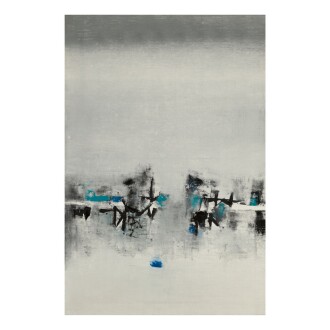Works by Vasudeo S. Gaitonde at Sotheby's
Vasudeo S. Gaitonde Biography
Vasudeo S. Gaitonde is regarded as one of India’s preeminent abstract painters. Although he was not an official member of the Progressive Artists' Group (PAG), Gaitonde played a major role in the artistic reinvention that followed Independence.
Born in Nagpur to Goan parents, Gaitonde was brought up in a working-class tenement in Khotachiwadi in Girgaon. In 1943, at the age of 19, Gaitonde was awarded a scholarship to study at the Sir J. J. School of Art in Mumbai, where he met fellow artists Tyeb Mehta, Akbar Padamsee, Sayed Haider Raza and Francis Newton Souza. Gaitonde's brief association with the Progressive Artists' Group and later the Bombay Group brought him into contact with the influential teacher Shankar B. Palsikar, who introduced Gaitonde to the Indian miniature watercolor technique. (S. Poddar, V.S. Gaitonde: Painting as Process, Painting as Life, Guggenheim Foundation & DelMonico Books, Prestel Publishing, New York, 2014, p. 19) Along with traditional Indian painting techniques, Gaitonde was also influenced by the work of the German Expressionist Paul Klee, who was to shape his artistic output during the 1950s and early 1960s.
By 1963, Gaitonde was beginning to receive recognition outside of India. The artist held successful exhibitions at Gallery 63 in New York and Gallery One in London. These shows resulted in Gaitonde receiving a prestigious Rockefeller Foundation grant in 1964, awarding him with a year-long stay in New York.
During his time in America, Gaitonde came into direct contact with the work of artists from the Abstract Expressionist movement, such as Adolph Gottlieb, which had a great impact on his oeuvre. His ideas and paintings also began to reflect his sustained engagement with Zen Buddhism and Chinese calligraphy.
Gaitonde produced very few works during his lifetime, partly due to his philosophical and meticulous approach to his art. He held strong beliefs in his identity as a painter and isolated himself from others, removing any distractions that would interfere with his goal of achieving the purest form of expression through light, color and texture. Gaitonde's primary concern was not with representation, but with the painted surface itself. In the artist’s own words: “A painting is simply a painting—a play of light and colour. Every painting is a seed which germinates in the next painting. A painting is not limited to one canvas, I go on adding elements and that’s how my work evolves ... There is a kind of metamorphosis in every canvas and the metamorphosis never ends." (M. Menezes, ‘The Meditative Brushstroke’, ART India Magazine, Vol. III, Issue III, 1998, p. 69)
During his lifetime, Gaitonde received several accolades including the Fleischmann Prize (1957), the Padma Shri (1971) and the Kalidas Samman Art Award (1990). In 2014, the Guggenheim staged V. S. Gaitonde: Painting as Process, Painting as Life, a retrospective featuring works from across Gaitonde’s prolific career.
Gaitonde passed away in New Delhi in 2001.
Read Less











